Developing quality assessments can be challenging for a number of reasons. And, because assessments are essential in so many student-focused decisions, it’s important to get them right. Here are eight steps that teachers and curriculum directors can use to create high quality, effective assessments:
1. Use assessments to uncover good decision-making evidence. Assessment should be considered integral to the instructional process, and the development of assessments with lesson-planning improves learning outcomes. When done right, planning assessment while planning lessons not only gives instructors the evidence they need to make sound decisions, but it also ensures that curriculum, instruction, and assessment form a cohesive program around which informed decisions can be made.
2. Align learning targets with assessment methods. Mismatches between the target and the assessment method will lead us to making incorrect decisions about a student’s position on the learning continuum. For example, knowledge learning targets are efficiently assessed using traditional selected-response type questions. However, learning targets requiring demonstration of a skill or the creation of products will require more innovative item types in order ensure the learning target is being assessed accurately.
3. Don’t mistake rigor with difficulty. Rigor relates to the extent to which students must transform knowledge (i.e., cognitive demand) in order to display proficiency. Think of it in terms of the thought processes occurring for students: demand connected to interacting with the question affects difficulty, while demand connected to forming a response affects rigor.
4. Leverage blueprinting to build out consistent instructional programs. By ensuring coverage of standards and accurately gauging mastery of specific knowledge and skills, blueprinting helps teachers pinpoint which learning targets need to be assessed and build out a consistent instructional program. For example, by focusing only on those learning targets that have an enduring nature, blueprinting pulls out the most important elements of learning. This, in turn, helps teachers make the best decisions related to student progress.
(Next page: 4 more steps to effective assessments)
5. Know the purpose behind the assessments. Instructors and curriculum directors who want to fully leverage the power of assessment in the quest to give students more ownership over their learning should always be able to answer this simple question: What is the purpose of this assessment? Regardless of how big or small, short or long, rigorous or simple the assessment is, this is a general question that should always be answered before administering any assessment to students. An early assessment during the first week of class, for instance, might incorporate recall and reproduction questions, which will be able to answer specific, pointed questions. Later assessments will, of course, be developed to answer different questions, which will require the assessment to have different characteristics.
6. Sample from the domain for enduring understandings. Select from the domain by considering the enduring elements that provide the evidence students have mastered the essential content and have a strong foundation for further learning. Moreover, sample a larger number of items from broader standards, and reduce the number when assessing more granular learning targets (i.e., observable objectives that can be measured to provide evidence of a student’s comprehension and potential). The targets must provide observable objectives that can be measured and be built around evidence for what a student is expected to be able to know and do.
7. Let student data guide decisions. Commit to making decisions about teaching and learning based on the data obtained from assessment. This means using assessment data for its intended purpose, evaluating it at the correct level-of-analysis, and letting it inform across the broad range of instruction, curriculum, and programming.
8. Know the value of post-assessment analysis. It’s important that teachers don’t forget to use the assessment data for all of the rich information they can provide. They should evaluate both the qualitative and quantitative information that’s provided by the assessment and use the student item analysis to gain insight into areas for further evaluation (e.g., the instruction itself, the domain sampling, etc.). For instance, post-assessment analysis allows you to see where you may have asked questions that caused students to use reasoning to respond but against a target where that knowledge wasn’t in place yet.
Ready, Set, Go!
By taking these steps, teachers can effectively give students ownership over their learning—a nirvana that all public and private K-12 schools often think about but can’t always master. The ability lies in using data to make informed decisions at the instructional, curricular, and programming levels. And, it starts when districts ask themselves questions like, “Where are our students in terms of progression toward mastery?” and “How can we effectively leverage assessment data to make informed decisions and help students take the next step (which, in turn, will be assessed for further evaluation)?”
From there, it becomes a productive cycle that districts can use, all the while honing their processes and ensuring that students are maximizing the ownership of their learning.
- 5 ways school districts can create successful community partnerships - November 21, 2024
- Trump picks Linda McMahon to lead, and possibly dismantle, Education Department - November 21, 2024
- 6 ways to create engaging elementary learning spaces - November 20, 2024


